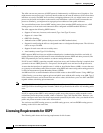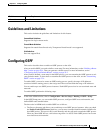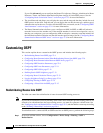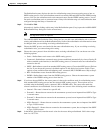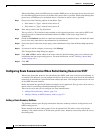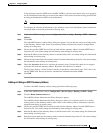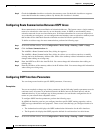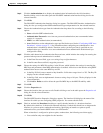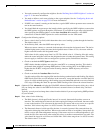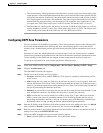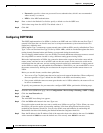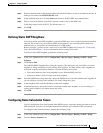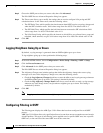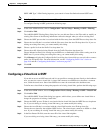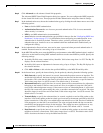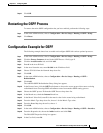
27-10
Cisco ASA 5500 Series Configuration Guide using ASDM
Chapter 27 Configuring OSPF
Customizing OSPF
• You need to manually configure the neighbor. See the “Defining Static OSPF Neighbors” section on
page 27-13 for more information.
• You need to define a static route pointing to the crypto endpoint. See the “Configuring Static and
Default Routes” section on page 25-2 for more information.
• If OSPF over a tunnel is running on the interface, regular OSPF with an upstream router cannot be
run on the same interface.
• You should bind the crypto map to the interface before specifying the OSPF neighbor to ensure that
the OSPF updates are passed through the VPN tunnel. If you bind the crypto map to the interface
after specifying the OSPF neighbor, use the clear local-host all command to clear OSPF
connections so that the OSPF adjacencies can be established over the VPN tunnel.
Step 12 Configure the following options:
• Enter a value in the Cost field, which determines the cost of sending a packet through the interface.
The default value is 10.
• In the Priority field, enter the OSPF router priority value.
When two routers connect to a network, both attempt to become the designated router. The device
with the higher router priority becomes the designated router. If there is a tie, the router with the
higher router ID becomes the designated router.
Valid values for this setting range from 0 to 255. The default value is 1. Entering 0 for this setting
makes the router ineligible to become the designated router or backup designated router. This setting
does not apply to interfaces that are configured as point-to-point, nonbroadcast interfaces.
• Check or uncheck the MTU Ignore check box.
OSPF checks whether neighbors are using the same MTU on a common interface. This check is
performed when neighbors exchange DBD packets. If the receiving MTU in the DBD packet is
higher than the IP MTU configured on the incoming interface, OSPF adjacency will not be
established.
• Check or uncheck the Database filter check box.
Use this setting to filter the outgoing LSA interface during synchronization and flooding. By default,
OSPF floods new LSAs over all interfaces in the same area, except the interface on which the LSA
arrives. In a fully meshed topology, this flooding can waste bandwidth and lead to excessive link and
CPU usage. Checking this check box prevents OSPF flooding of the LSA on the selected interface.
Step 13 (Optional) Click Advanced to display the Edit OSPF Advanced Interface Properties dialog box, which
lets you change the values for the OSPF hello interval, retransmit interval, transmit delay, and dead
interval.
Typically, you only need to change these values from the defaults if you are experiencing OSPF problems
on your network.
Step 14 Enter values for the following:
• The Hello Interval, which specifies the interval, in seconds, between hello packets sent on an
interface. The smaller the hello interval, the faster topological changes are detected, but more traffic
is sent on the interface. This value must be the same for all routers and access servers on a specific
interface. Valid values range from 1 to 65535 seconds. The default value is 10 seconds.
• The Retransmit Interval, which specifies the time, in seconds, between LSA retransmissions for
adjacencies belonging to the interface. When a router sends an LSA to its neighbor, it keeps the LSA
until it receives the acknowledgement message. If the router receives no acknowledgement, it will
resend the LSA. Be conservative when setting this value, or needless retransmission can result. The
value should be larger for serial lines and virtual links. Valid values range from 1 to 65535 seconds.
The default value is 5 seconds.



